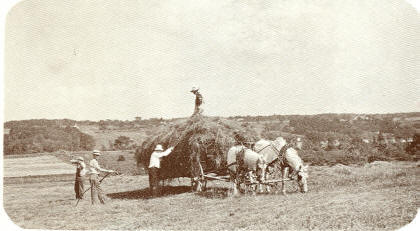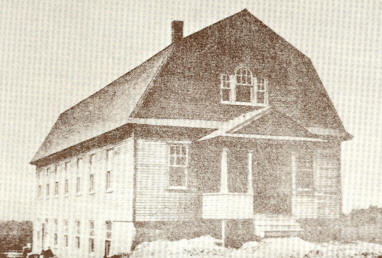|
Agriculture
|
|
 Haying At Grandview Farm On The Upper Pond Road, 1914
|
One summer boarder at the
Webber farm was an amateur photographer. In August, 1914 he
wrote back from Waterbury, Connecticut, to Harold Webber, "How's
this for photo work, Harold? Got some other dandies.
Glad to hear you've a big crowd [of summer folk] up there. source: Litchfield Yesterdays |
| Deep clay loam and rich silt
from the streams made much of Litchfield's surface tillable and
fertile. In 1925 the Maine Agricultural Census reported 20,555
acres in 222 farms in town, with 6382 of those acres in harvested
crops. In 1875 James A. Chase had bought a farm on the Plains
and set out a large apple orchard. At about the same time
William and Sarah Springer had farmed on the Huntington Hill Road
and had orchards. The apples were hauled by horses and wagons
to Richmond, whence they were taken down the Kennebec by boat and
sailed to Boston and New York. For some fifty years in the
middle 1800's Litchfield farmers raised wheat as well as corn for
home use. John Smith's 1848 letter relates that most early implements: ox sleds, wooden-tooth harrows and hay rakes were home made. It was a long time before the coming of cart wheels, and hods were used to carry manure about in the field to put in the holes for planting corn. William Potter, who came in 1782, was the first man in town to use a plow. Corn was the staple food grain; when early frosts destroyed the crop settlers suffered bitterly through the long hard winters. But these hardy pioneers presevered, and by 1807 when the president of Yale College, Timothy Dwight, passed through Litchfield on his Maine travels he was able to report that the town was apparently the most cultivated. Apples continued to be raised for many years in considerable quantity; enough to keep Frank Wyman's steam cider mill busy during the late 1800's. As late as 1924 the state agriculture census recorded 16,876 bearing apple trees in town. The hay crop was and is a significant part of Litchfield's agriculture. In earlier days the hay was fed to oxen and steers, and then as dairying increased to cows and young cattle as well. Neither horses nor trucks had entirely replaced oxen by 1925. Although our people kept 305 horses and 11 colts that year they also had 24 oxen and 196 steers. There were in addition two tractors in town. By 1940 fifteen farms reported owning 18 auto trucks. Poultry raising for meat as well as for egg production had remarkably increased since 1925. The fattening of broilers under contract to large processing firms has added a new dimension to poultry farming. The small dairy farms of the first quarter-century which ran retail milk routes have been replaced by fewer, and much larger, dairy farms. These sell milk wholesale to out-of-town dairies to be processed and trucked back to local stores and supermarkets for retail sale. source: Litchfield Yesterdays
|
 Frank O. Berry Raking Hay On The Home Place About 1951.
|
 Litchfield Fair And Farmers Club |
The Litchfield Agricultural
Society was organized in 1857 and held its first exhibition the next
year. By 1897 the town history stated "The annual exhibitions
of this society have probably never been equaled in any town of the
size of Litchfield in this State in point of celebrity and
attendance. Many is the time when the attendance has been
estimated to number ten thousand." On the morning of October 6, 1877, it was cold and windy. The roads were filled with vehicles of all descriptions hurrying to the Fairgrounds. In the hall the largest squash ever grown in Maine was displayed. It measured more than seven feet and weighed more than a barrel of flour! Among the fancy work was a quilt sewn by a girl 5 years of age and containing 15,999 pieces. Peanut vendors, lead pencils and soap dealers were on hand to display their wares. In 1904 after a period in which the annual exhibition had declined, it was reorganized as the Litchfield Farmers Club, which name continues to the present. About 12,000 people attended the annual Fair in 1910, and such events as the greased pig races were held. That was the first year in which cash premiums were paid for prize exhibitions. Today the annual fair draws crowds of about twelve thousand annually and greased pigs are still being caught each year by happy youngsters. A Saturday afternoon baby show still affords an opportunity for fair-goers to view the most beautiful babies in town. Each one is a blue ribbon baby! Many changes have taken place at the old trotting park (now Litchfield Fairgrounds) but the spirit of reunion with old friends prevails as it did so many years ago. source: Litchfield Yesterdays
|
| In March, 1875, twenty-seven farm people, most of them from the northern part of the town, organized the Grange and elected John Woodbury Worthy Master. For many years the group met at the North Litchfield (District No. Six) schoolhouse and then in the Smith store building, which they moved to the the site of the present hall. The first new hall (shown) was completed in 1919 and was occupied until it burned in 1969. The present hall, first occupied in 1971, was built on the same site under the direction of the committee made up of Fred Weeks, Maurice Hilton, Chester Small, Verna Nuzzo and Estella Brown. For years the Grange met on Saturday afternoons with an all-day meeting once a month during the winter. The group began serving dinners at Litchfield Fair about 1918, and during the summer they now serve public baked bean suppers of notable quality each Saturday night to residents and summer folk. The society celebrated its centennial in 1975 with ten "Golden Sheaf" (50 year) members living including Delmar Small, Mabelle Tucker and Frances Chesley - members for 60 years or more. source: Litchfield Yesterdays
|
 Litchfield Grange No. 127, Patrons Of Husbandry |